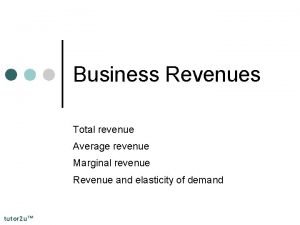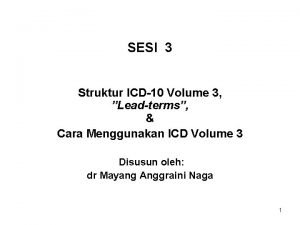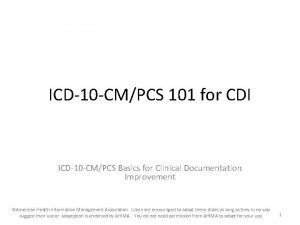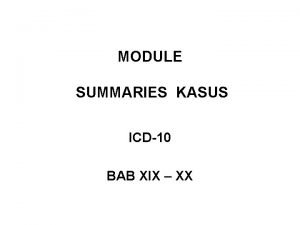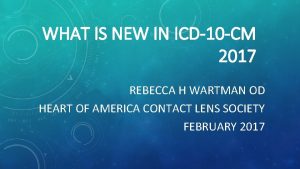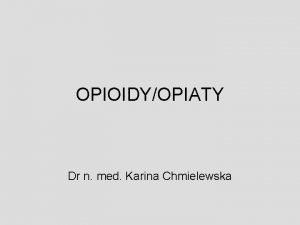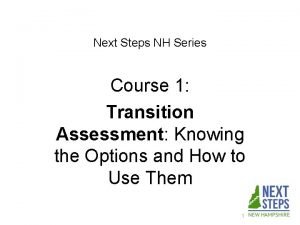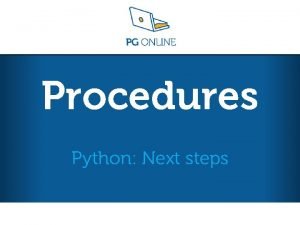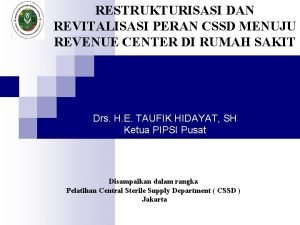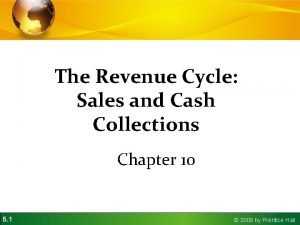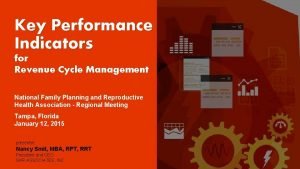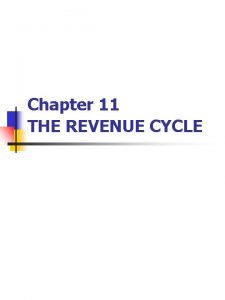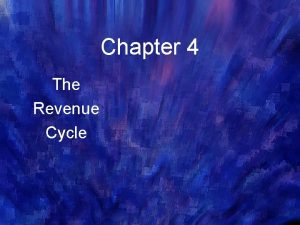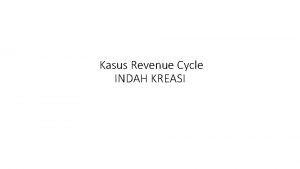Health Center Revenue Cycle ICD10 Next Steps Resources


























- Slides: 26

Health Center Revenue Cycle ICD-10 Next Steps, Resources 1 David P Wagner, MHCM FQHCConsultant@gmail. com

Definitions and Acronyms Used Community Health Centers (Includes all 330 grantees) Look-A-Likes (LAL) In-Scope Services (Table 5) Revenue Cycle Uniform Data System Report (UDS) Prospective Payment System (PPS) Wrap-Around Payment (WRAP) HCPCS/CPT/ICD-10 2

Revenue Cycle – 6 Points of ICD-10 Impact Front End Visit Documentation Charge Capture Coding Charge Entry Claims Transmission Payment Posting Denial Management Working Accounts Receivable 3

Revenue Cycle – Front End Pre-Visit – Before the patient presents to the office for his/her appointment Scheduling – Establish Reason for Visit Eligibility Verification Patient Registration – As the patient presents to the office for his/her appointment Complete Paperwork Present Insurance Card Re-validate Eligibility 4

Revenue Cycle – Visit Documentation Reason for Visit Pertinent Family/Personal Medical History Physical Exam Differential Diagnosis (includes test review) Treatment Plan Personalized Patient Care Plan 5

Revenue Cycle – Charge Capture All aspects of Entire Encounter are Captured Properly Level of Service – Type of Service Diagnostic Testing Performed Wellness Services Performed Counseling Performed Includes Non-Billable Data Capture for UDS 6

Revenue Cycle - Coding All charges captured are coded properly to the actual service delivered ICD 10 coding is done at the most specific level ICD 10 coding is matched properly to the charges (even those “charges” that are captured solely for the submission of data** ** The health center MUST understand completely how its UDS report is prepared from the data in the database to ensure data is captured properly at this stage of the revenue cycle. 7

Revenue Cycle – Charge Entry Although coding and charge capture was performed, one last step is required to verify the data is entered in the proper format for prompt and maximum payment as well as UDS reporting This stage includes: Validating all CPT / HCPCS codes have appropriate ICD 10 diagnosis codes attached, in the right order Ensuring coding is proper to the insurance to be billed 8

Revenue Cycle – Claims Transmission Scrubbing claim through clearinghouse Submit and review the claim at the clearinghouse level This will indicate any ICD 10 major errors but will not indicate errors such as incorrect ICD 10 paired to procedure codes Incorrect insurance plan being submitted to will show here NOTE: While the clearinghouse can identify an incorrect pairing of codes, they cannot generally recommend the correct pairings as they do not employ coders. 9

Revenue Cycle – Payment Posting Payment posting done by Electronic Remittance Advice (ERA) is much faster, easier, and efficient Payment posting done by Electronic Remittance Advice is potentially troublesome causing lack of reimbursement Payments can be reduced or denied erroneously Harder to spot reduced payments due to automated processing of payments when ERA is utilized NOTE: Ensure UCR files are loaded, kept current, and monitored during payment posting so any payment variances are either manually or preferably automatically flagged for review. 10

Revenue Cycle – Denial Management A continuous stream of information on submitted claims is returned (daily, weekly, with payment) All denials should be tracked with metrics applied to consistently improve the system – Group Per Revenue Cycle Category Front-End Processing Denials Charge Capture Denials Coding Denials Claim Processing Denials 11

Revenue Cycle – Working Accounts Receivable Work quickly and continuously Develop procedures for ICD-10 related denials Watch for patterns/trends in matching ICD-10 codes with CPT/HCPS codes Watch for shifts in these patterns once patterns emerge Monitor payer to payer Track problems and issues by payer and by category (i. e. , ICD-10/Procedure code matching; UCR denials; processing issues 12

Consider a 360 Audit Some highly performing health centers use a 360 program for quality improvement/quality assurance Consider reviewing at least 5 patient encounters per quarter provider from the time the appointment was set until the time the funds received from the visit are accounted for in the daily deposit including all copays and deductibles paid by the patient. These 360 audits include information from the financial, operational, and provider perspectives and can double as peer review for provider privileging 13

PPS System for Health Centers (Updated Feb/2016) New Patients, Initial Patient Preventive Exam, Initial Annual Wellness Exam and Subsequent Annual Wellness Exams are paid over 30% higher PPS. Grandfathered Tribal (GFT) FQHCs are in a different category and should be handled as directed previously by CMS. Use of the “G-Codes” required in combination with the proper ICD-10 codes An IPPE should only be coded with the ICD-10 appropriate for preventive care An AWV should only be coded with the ICD-10 appropriate for wellness care This leaves injury and diagnosis codes open for other visits THIS IS NOT A CODING WEBINAR – CHECK CODING WITH YOUR LOCAL MEDICARE CARRIER, MEDICAID, and PAYERS 14

PPS System for Health Centers - continued G codes: G 0466 - FQHC visit, new patient G 0467 - FQHC visit, established patient G 0468 - FQHC visit, IPPE or AWV G 0469 - FQHC visit, mental health, new patient G 0470 - FQHC visit, mental health, established patient G 0008 – Influenza Vaccine G 0009 – Pneumococcal Vaccine G 0010 – Hepatitis B Vaccine 15

PPS System for Health Centers - continued Multiple Visits on Same Day Allow Separate Payment (IF ICD 10 and CODE indicate such) Separate payment allowed for: Subsequent Illness or Injury Mental Health Visit (careful with coding if same day as an illness exam) Diabetes Counseling and Medical Nutrition Services (DSMT)* (very tricky billing for this- must be certified) Separate payment not allowed for: Transitional Care Management (TCM) Chronic Care Management (CCM) Many Screenings including Glaucoma, Prostate, Breast NOTE: These services are paid in the PPS rate but it is important to process them through the system for proper documentation. 16

Assessing ICD-10 at Your Health Center Assess your ICD-10 Implementation and its impact on the Revenue Cycle (and required reporting) by establishing Key Performance Indicators (KPI) Address Opportunities for Improvement Troubleshoot issues identified during your assessment Develop and deploy tactics like system enhancements and staff training to continuously maximize reimbursement Maintain Your Progress and Keep Up to Date on ICD-10 17

Assessing Your Progress Establish KPIs Establish KOIs Important to Track Requests for Additional Information Days to Final Bill Daily Charges/Claims Days to Payment Clearinghouse Edits Claims Accepted/Rejected Incomplete or Missing Charges rates Claims Denial Rate Reimbursement Rate Coder Productivity Volume of Coder Questions Incomplete or Missing Diagnosis Codes Use of Unspeciied Codes Medical Necessity Pass Rate 18

Assessing Your Progress Establish Baseline for KPIs Find pre-ICD-10 baseline data on chosen KOIs from your information at hand You may have in old reports from your health center You may be able to mine data from your current practice management system (PMS) Outside sources may have pre-ICD-10 baseline data on your practice Claims clearinghouses Third-party billers System vendors 19

Assessing Your Progress Collect, Organize, Report Create a process for gathering ICD-10 feedback data Consider creating a 360 analysis on a number of patients per month Review reports with your current PMS system that may yield data Check with billing agency used for data Organize data and have ready the pre-ICD-10 performance, periodic performance, and metric established by QI/QA Report the information in an operational dashboard Track the data and compare to baselines Continuously report on the periodic basis established by your QI/QA committee 20

Addressing Your Findings --Check Clinical Documentation and Code Selection Review documentation prior to October 2015 and the current record to identify any trends or correlations between errors and actual data entered into records Are there differences in documentation structure or required content? Are vendor templates, provider preferences, or payer requirements creating any documentation anomalies? Does the record support the selection of the procedure and diagnosis coding? 21

Addressing Your Findings --Understand Your Processes for Code Selection Who selects diagnosis codes? are appropriate/compliant? Who ensures the codes Clinicians Billers Certified Coders Vendors (billing agents) (Be sure to account for ALL IT SYSTEMS at every point of the revenue cycle) 22

Addressing Your Findings --Provide Educational Resources for Clinicians and Staff Official CMS Educational Resources https: //www. cms. gov/Medicare/Coding/ICD 10/Provider. Resou rces. html Specialty Resources Guide https: //www. cms. gov/Medicare/Coding/ICD 10/Downloads/IC D 10 Specialty. Resources. Guide 20151123. pdf Coding and Clinical Documentation https: //www. cms. gov/Medicare/Coding/ICD 10/ICD-10 -Coding. Resources. pdf 23

Addressing Your Findings --Check for Systems Issues Verify that all systems have implemented ICD-10 Review how the UDS reporting is performed specifically inside of your system(s) If you have disparate systems (i. e. , a separate dental and medical record that are not feeding through a centralized data system) check the interfaces to ensure coding is properly coming across Monitor shifts on Table 6 A and 6 B between 2014, 2015, and your current UDS reports 24

Helpful Resources http: //bphc. hrsa. gov/programrequirements/policies/pin 201401. html http: //bphc. hrsa. gov/programrequirements/centerguide. html http: //www. nchph. org/training-and-technical-assistance/ https: //www. cms. gov/Medicare-Fee-for-Service. Payment/FQHCPPS/Downloads/FQHC-PPS-Specific-Payment-Codes. pdf https: //www. cms. gov/Regulations-and. Guidance/Manuals/downloads/bp 102 c 13. pdf 25

Questions David P Wagner, MHCM Health Center Consultant FQHCConsultant@gmail. com 855 -493 -FQHC (3742) www. fqhcconsultant. com 26
 X.next = x.next.next
X.next = x.next.next Marginal revenue
Marginal revenue Erythropapulosa
Erythropapulosa Kode icd sakit telinga
Kode icd sakit telinga Keracunan makanan icd 10
Keracunan makanan icd 10 Isi volume 3 icd-10 adalah
Isi volume 3 icd-10 adalah Icd-10 orthopaedics
Icd-10 orthopaedics Cdi icd10
Cdi icd10 Latex allergy icd 10
Latex allergy icd 10 Icd10 sungsang
Icd10 sungsang Isrr icd 10
Isrr icd 10 Icd 10 code for microhematuria
Icd 10 code for microhematuria Icd 10 code for armd
Icd 10 code for armd Opioidy
Opioidy Transformation processes
Transformation processes Fixed resources
Fixed resources Renewable resources vs nonrenewable resources
Renewable resources vs nonrenewable resources Brigance transition skills inventory
Brigance transition skills inventory Macmillan next steps
Macmillan next steps Python next steps
Python next steps What is procedure in python
What is procedure in python Next steps with academic conversations
Next steps with academic conversations Next steps with academic conversations
Next steps with academic conversations Contoh revenue center
Contoh revenue center Basic revenue cycle activities
Basic revenue cycle activities Rea model cardinalities
Rea model cardinalities Revenue cycle management kpis
Revenue cycle management kpis

